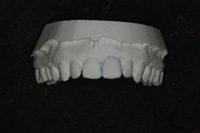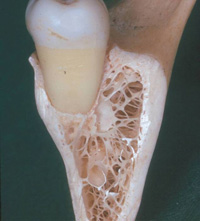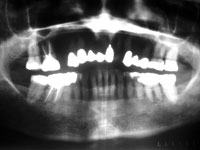Let me begin by elucidating the fact that I haven’t any degrees in business administration. I cannot place an MBA or a PhD in economics after my name. In fact, I don’t even have one of those certificates of completion that you get after a 3-day management course. However, what I do have is a decent grasp on the reality of a high “fee-for-service” practice in “average Home Town, USA.” This article is dedicated to those practitioners who have struggled for years with their fees…struggled with the questions of how much they should charge; how costly their fee increase is to patient flow; how you get from $650 to $1,100 for a crown; and how long it takes to make a change.
| Figure 1. Weekly Performance Monitor |
|
Week of- ___________ Productivity Production _____________________________ Collections_____________________________ How Much Down Time? _________________________________________________________ Performance Number of New Patients: _________________________________________________________ Number of Patients Seen: _________________________________________________________ Number of LATE Seating: ________________________________________________________ Number of Compliments: _________________________________________________________ Number of Complaints: ___________________________________________________________ Hygiene Production for Week: _____________________________________________________ Quality Number of Clinical Procedures Repeated: ___________________________________________ Number of Remakes Necessary: ___________________________________________________ Team Contentment Sick Days: ______________________________________________________________________ Lateness / Tardiness: ______________________________________________________________ Terminations: ____________________________________________________________________ |
| Figure 2. How Are We Doing? | |||||||||||||||||||||||||
|
TRUTH NO. 1
Your fees should be based on your commitment to clinical excellence and customer service. Nothing else. Not where you live. Not on your UCR. Just on your level of excellence. I am acutely aware that this popular theory is vague. How do you translate a commitment to excellence into fees?
(1) How up-to-date is your continuing education? Twenty hours per year doesn’t warrant a raise.
(2) How much of a command of restorative materials do you have? Do you really feel confident about when to treatment plan a veneer? What about Empress, Procera, or a PFM? How about occlusion? Do too many of your restorations fracture or debond? Do you struggle with removable prosthetics? Do you not recommend implants because they are not in your armamentarium?
| Figure 3. Suggested Areas of Study for Staff | |||||||||||
|
TRUTH NO. 2
Raising fees will equal losing patients. End of story. Prepare to have your feelings hurt, your ego deflated. Brace yourself, because the patient you lose might be that exceptional veneer case you did years ago, or the patient you got out of pain on a Sunday (in the snow). It might even be your golfing buddy or the friends that helped your wife with your 40th surprise birthday party. It doesn’t matter. Some patients are cost-based, and if you raise your fees, they’ll leave you.
TRUTH NO. 3
A high fee-for-service practice takes time. Don’t let anyone tell you otherwise. Don’t fall for that “double-your-fees-and-you-won’t-lose-half-your-patients” story. Forget for a moment the various management guru theories. Think about the world you live in…the best clothing stores, restaurants, or furniture stores. Did you ever hear of one of them doubling their fees over 1 year, let alone overnight? You’ve got to lay out a plan. You’ve got to know how good you are now, and what you aspire to be. Here’s one way to do it. Set up three staff meetings, 60 days apart, dedicated only to fees.
MEETING 1: SELF-EXAMINATION
Where are you now as an organization? Is there a constant leak of nonreturning patients? How’s your “on time” record? Are there numerous complaints or misunderstandings about patients’ bills? How is the attitude of the staff to the patients? How about to each other? Is this place happy? What about your office environment? It doesn’t have to be a $200,000 renovation job. New rugs, wallpaper, and a clean waiting room go a long way toward improving morale for both staff and patients. So meeting number one might hurt some feelings. It needs to be honest. Chances are you won’t have all the answers, so take 2 months and survey (Figures 1 and 2).
Note that Figure 1 is a Weekly Performance Monitor and is broken down into the following:
- Productivity: Every practice needs a bottom-line productivity to stay profitable. A conflict between productivity and excellence doesn’t exsist if you don’t allow it. However, the only way to keep them in balance is to track the data. A great week that yields on-time appointments, great care, and a happy staff, but is unprofitable, is no better than the frenetic week with the multitude of problems that come from running late from room to room, with substandard care and yet immense profitability. Without exception, the most successful practices find balance.
- Performance: This section leaves nothing to chance. Go ahead. Ask your staff next week how the office has been doing lately. Have we been on time? Any complaints? How was the hygiene department last week? Guess what? Nobody will really know. No one can remember without tracking it. Assign the front desk “exit receptionist” to track complaints or compliments. The assistants can keep a chart on any seating that was 15 minutes late or more. In fact, everyone should share the responsibility of tracking how you are doing. At first it will seem like a lot of work. Eventually, it will just be a part of how you exist.
- Quality: This is for the clinical portion of the staff. The very act of tracking repeated clinical procedures such as a newly needed impression, a wrong shade, an inaccurate centric record, or even caries diagnosed on a bite-wing under a crown you did a year ago (I know, never happens to you) will inspire you to get it right the first time. You can’t guess on this stuff—you have to track to see if your course with Dr. Dawson yields less insertion adjustments, or that your mastery of ceramics enables you to select appropriate materials (Empress vs Spinell vs Captek, etc) that result in outstanding aesthetics without a return to the lab four times. Tracking requires work. It is tedious, but positive reinforcement will provide confidence to stand tall behind that yearly 10% raise you have justly earned.
- Team Contentment: Staff members that always seem to get sick on Mondays or can’t figure out how to be at the morning meeting on time are not content. They just don’t care as much as those who do in fact make a responsible commitment. It is demoralizing to other team members when you look the other way. Part of the reason you look away is because you don’t remember. They couldn’t possibly have missed seven Mondays last year, could they? You need to be fair. You need to remember. You need to track team contentment.
Figure 2 reflects one patient “exit interview” you might use. It takes all of 5 minutes. In the morning meeting, choose one or two patients who might be completing treatment to be interviewed. Keep your results in a large three-ring notebook. Implore your patients to be honest. Assign one staff member (usually the new patient coordinator) to review the results before your monthly meeting. Delete or add questions relevant to your office. However, asking questions about how long they waited or if their bill was what we said it would be goes a long way toward “prevention.” Don’t brush this off. Don’t pay someone else to do it. Successful, high-fee organizations care more. Part of caring more is taking the time and energy to see where you are. Once you have a measure of where you are, address the areas that will warrant a fee increase.
MEETING 2: HOW WILL WE IMPROVE?
Drs. Frank Spear, John Kois, and Carl Misch don’t get their fees because of where they live. They get them because they’ve paid big-time dues. Education, research, sweat, and contributions to the profession have given them their fees. OK, so you’re not one of them. But anyone can elevate their present skills to warrant a fee increase. Here’s one way to do it:
•Hold two annual meetings (in February and August) to select courses for the calendar year. Establish a goal of two for the clinical staff and one per quarter for the doctor. Start four notebooks labeled “Front Desk,” “Hygiene,” “Assistants,” and “Doctor.” Save all course information. Areas of study that we encourage can be reviewed in Figure 3.
MEETING 3: MEASURE YOUR PROGRESS
CONCLUSION
Let’s be honest. Not all offices embrace the same commitment over the course of a career. A wide range of roads can be taken. Often, our professional interest takes a back seat to other “stuff.” Hobbies, sports, or secondary careers predominate. The result is a lack of continued education, and sometimes, a lack of excellence. Flourishing in a high fee-for-service practice has infinite rewards, the greatest of which will be the satisfaction of success on a—pardon the cliché—“road less traveled.” The truth is that mediocrity is far less challenging. It doesn’t require any systems. The truth is that a high fee-for-service practice has a price that will not be worthwhile to some. However, if the present snapshot of your practice includes a spiraling, lost-in-space organization bound by the “handcuffs” of stagnation, the “truth” could set you free.
Dr. Rasner is a general practitioner from Bridgeton, NJ. Despite practicing in one of the more economically challenged areas in the country, his practice has evolved as a model of enduring success. Combining clinical excellence, extraordinary customer service, and visionary leadership, he has created the “dream” practice on which he lectures both nationally and internationally. He can be reached at (800) 337-8435.











